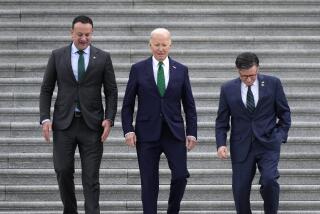Money Supply Climbs $3.9 Billion
- Share via
NEW YORK — The nation’s basic money supply rose $3.9 billion in early January, the Federal Reserve Board reported Thursday.
The increase exceeded analysts’ expectations, but the bond market rallied because of other signs that the Federal Reserve was easing the availability of money, according to Maury N. Harris, chief economist at Paine Webber.
The Fed said M1 rose to a seasonally adjusted $628.5 billion in the week ended Jan. 6 from $624.6 billion in the previous week. M1 includes cash in circulation, deposits in checking accounts and non-bank travelers checks.
For the latest 13 weeks, M1 averaged $619 billion, an 11.8% seasonally adjusted annual rate of gain from the previous 13 weeks.
M2, M3 on Targets
M2, a broader measure of money, was $2.56 trillion in December, up from $2.55 trillion in November. M3, the broadest measure, rose to $3.21 trillion from $3.19 trillion in November.
In contrast to M1, the figures on M2 and M3 both were in line with analysts’ predictions, indicating overall stability in the money supply, said John Knight, a general partner in Refco Partners, a fixed-income securities dealer.
M2 is made up of M1 and such accounts as savings deposits and money-market mutual funds. M3 is the sum of M2 plus less-liquid accounts, such as certificates of deposit in minimum denominations of $100,000.
Dealers had predicted that the basic money supply, M1, would increase about $2.3 billion, although estimates had ranged from no increase to a $4.5-billion increase.
The increase puts M1 $3.8 billion above the upper limit of the Fed’s target through the first week of 1986. The Fed has tentatively said that it wants the basic money supply to grow 4% to 7% in 1986.
Ordinarily, a big jump in the money supply depresses the bond market because it decreases the chance that the Federal Reserve will act to ease credit. However, the bond market rallied after the numbers were released at 4:30 p.m. EST.
The benchmark 30-year bond, which had been down in price, rose to finish the day sharply higher, and the yield on three-month Treasury bills continued downward.
Harris said traders were impressed by the small amount of bank borrowings from the Federal Reserve System because they thought it indicated that the Fed had injected large amounts of reserves into the banking system. That would tend to push down interest rates.
The Federal Reserve said bank borrowings from the Federal Reserve System averaged $143 million in the two-week period ended Wednesday, down from $866 million in the previous two-week period. The Fed said the total was the lowest since it changed its reporting method on Feb. 4, 1984.
In another positive note, the Federal Reserve said net free reserves totaled $1.109 billion in the two weeks ended Wednesday, up from a revised total of net free reserves of $464 million in the previous two-week period. The Federal Reserve said total adjusted reserves of member banks averaged $45.693 billion in the two weeks ended Wednesday, down from $45.754 billion in the previous two-week period.
In other reports:
- The Federal Reserve Bank of New York reported that commercial and industrial loans at major New York City banks rose $214 million in the week ended Jan. 8, compared to a gain of $1.029 billion a week earlier.
The Federal Reserve Bank of St. Louis reported that the monetary base--the seasonally adjusted total of member bank reserves held at Federal Reserve banks and cash in bank vaults and in circulation--was $237.6 billion in the week ended Wednesday, up from $236.8 billion a week earlier.
More to Read
Inside the business of entertainment
The Wide Shot brings you news, analysis and insights on everything from streaming wars to production — and what it all means for the future.
You may occasionally receive promotional content from the Los Angeles Times.










